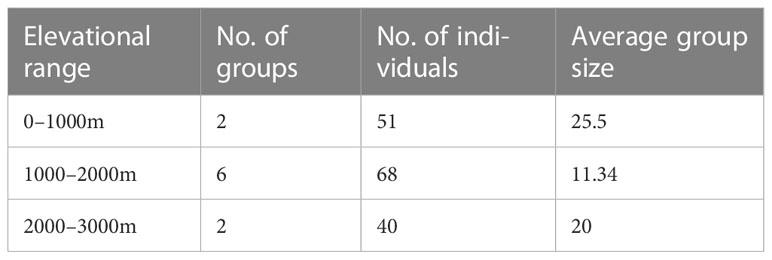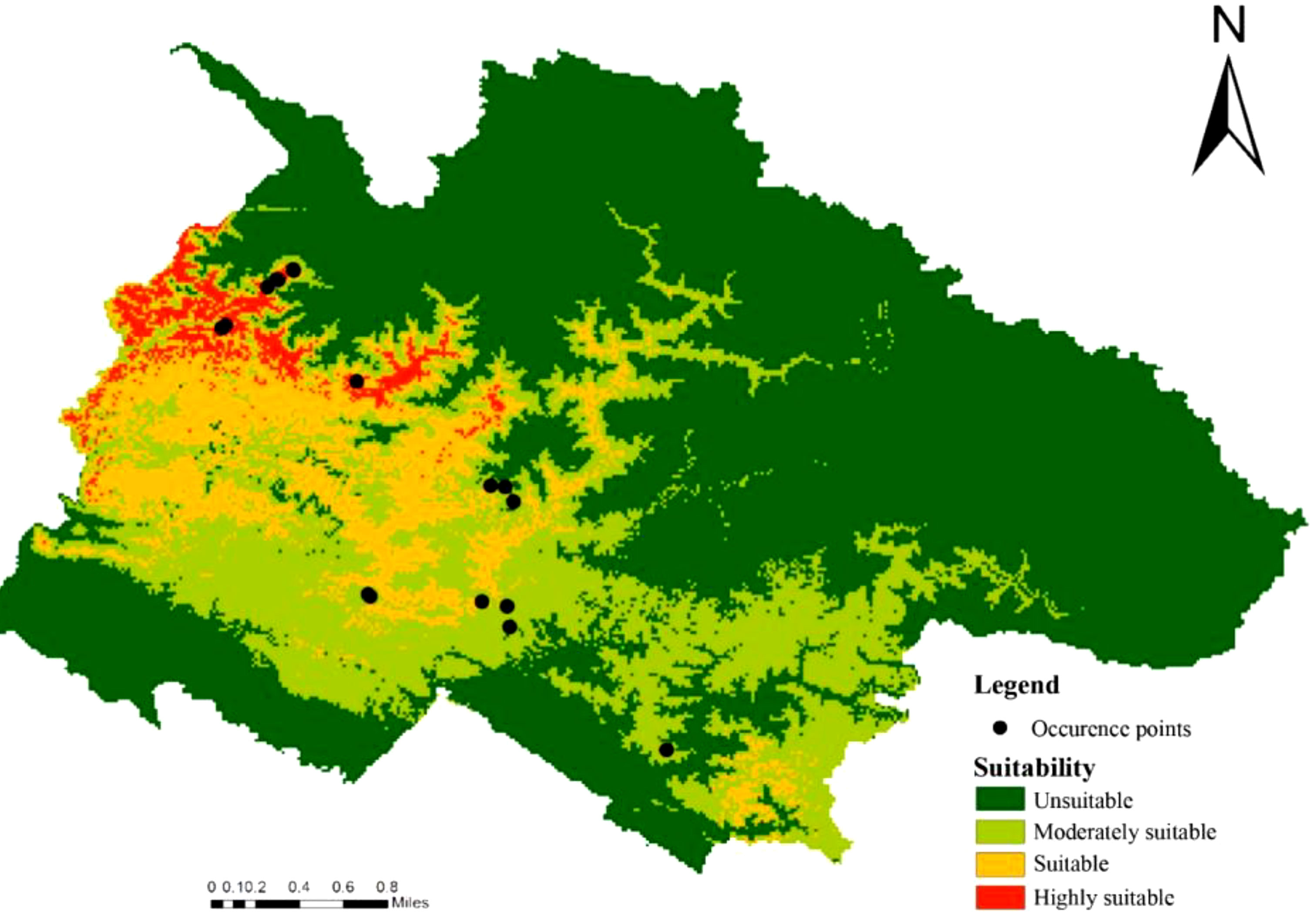- 1Central Department of Zoology, Institute of Science and Technology, Tribhuvan University, Kathmandu, Nepal
- 2Conservation Himalaya, Kathmandu, Nepal
- 3Nepal Biodiversity Research Society (NEBORS), Lalitpur, Nepal
- 4Departments of Psychology, Global Health, and Anthropology, Center for Global Field Study, and Washington National Primate Research Center, University of Washington, Seattle, WA, United States
Anthropogenic climate change can have a negative impact on the distribution of habitat specialist species with narrow distributional ranges. Among the many areas around the world affected by climate change, the Himalayan region in particular is experiencing marked effects of global warming on its climatic patterns and life forms. This study assessed the current distribution of Assamese macaques (Macaca assamensis) in western Nepal, and projected their likely distribution (via habitat suitability modeling) for the years 2050 and 2070 under the two most plausible greenhouse gas emission scenarios (RCP4.5 and RCP6.0). We recorded a total of 159 Assamese macaques belonging to 10 groups (nine of them residing outside of protected area networks) between 684m and 2550m asl in western Nepal. Climatic niche modeling predicted that 37.03% (25,114 km2) of the total area of western Nepal (67,813 km2) represented suitable habitat of the species, the majority of which ranged between 1000 m and 2000 m asl. Future projections of the current climatic niche of the Assamese macaques revealed a consistent decrease in the suitable habitat for 2050 and 2070 in both of the greenhouse emission scenarios tested. With the RCP6.0 scenario, almost 57% of the current highly suitable habitat would be lost by 2070 with remaining suitable habitat shifted towards higher elevations. The loss of habitat directly affects the species survival and the range shift towards higher elevation exposes them to new areas for conflict with humans. Therefore, the Assamese macaque population in western Nepal requires a high conservation priority with the establishment of new protected areas.
1 Introduction
The Assamese macaque (Macaca assamensis) is one of the members of the sinica-group of macaques that is distributed in across south and southeast Asia including Bangladesh, Bhutan, China, India, Lao People’s Democratic Republic, Myanmar, Nepal, Thailand and Viet Nam (Boonratana et al., 2020). They prefer a sub-tropical, mid-hill area having broadleaved riverine forest, broadleaved evergreen forest, and mixed deciduous forests (Wada, 2005; Khanal et al., 2019; Choudhury, 2022). Owing to a decline in population due to habitat loss and hunting the species is listed as Near Threatened in the IUCN Red List of Threatened Species (Boonratana et al., 2020). Based on the relative tail length, the Assamese macaque is considered to be composed of two distinct sub-species, the eastern subspecies (M. a. assamensis) and the western subspecies (M. a. pelops) (Choudhury, 2022). The eastern sub-species is distributed east of the great bend of the Brahmaputra River whereas the western subspecies is distributed west of the Manas River (Roos et al., 2014) to the far-western region of Nepal (Khanal et al., 2019).
The Nepal population of Assamese macaques is morphologically different in body mass and relative tail length than the rest of the population of the western subspecies (M. a. pelops) in Bhutan and north-eastern India (Molur et al., 2003). Additionally, they consist of darker fur color with fleshy pink face and darker nasal area than observed in other populations (Chalise, 2005). Therefore, it is likely that this population qualifies for a distinct species status which is further supported by a recent phylogenetic study using multiple mitochondrial and nuclear loci (Khanal et al., 2021). The population is threatened due to its restricted distribution and continuing decline in size and quality of the habitat (Boonratana et al., 2020). Given its restricted range, threats to its population and habitat, and small numbers in fragmented patches, the Nepal population of this macaque is categorized as Endangered (Chalise, 2013; Boonratana et al., 2020), and it is legally protected by the National Park and Wildlife Conservation Act 1973 of Nepal (Khanal et al., 2021).
The Nepal population of Assamese macaques has a disjunct distribution, especially in the forest fragments of the mid-hills of Nepal (Chalise, 2013). Previously, the westernmost distribution limit of the species was thought to be the Kaligandaki River in central Nepal (Wada, 2005; Boonratana et al., 2020). However, our recent studies have reported several groups of the Assamese macaques from far-western Nepal almost 300 km nautical distance west from the previously believed distribution limit (Khanal et al., 2019; Khanal et al., 2021). The groups of the population in Nepal are sparsely distributed and the average group size is smaller than the other macaque species, rhesus macaque (M. mulatta) inhabiting the Nepal forests and urban setups (Chalise et al., 2005; Chalise, 2013; Khanal et al., 2019). The majority of the population resides outside the protected area system of the country and human-macaque conflict (such as crop raiding and retaliatory killing) is posing a threat to their survival (Adhikari et al., 2018; Khanal et al., 2019). Additionally, ongoing anthropogenic global warming could have a significant effect on distribution and habitat availability of the species which in turn could lead to increased human-macaque conflict.
Assamese macaques are reported mainly from the riverine broad-leaved forests in the mid-hills of Nepal from 130 m to 2650 m elevation (Khanal et al., 2019). Their distribution in eastern and central Nepal is reported from almost all the river basins (Chalise, 2013). However, their presence in the area west of Kaligandaki River and east of the Karnali River basin has yet to be confirmed by field surveys. The subpopulation residing in the Karnali River basin and west of it is an isolated subpopulation that has been recently reported (Khanal et al., 2019). This westernmost subpopulation has been found to be threatened due to multiple reasons including human-macaque conflicts, lack of awareness among local people in distinguishing the notorious crop raider, the rhesus macaque and legally protected Assamese macaque because of their imperceptibly different morphology.
The Himalayan region is an area highly affected by climate change (Shrestha et al., 2012). In the Nepal Himalaya, researchers have predicted that a number of animal species will lose their habitat and experience a range shift towards higher elevations (Aryal et al., 2016; Lamsal et al., 2018; Bhattacharyya et al., 2019). Western Nepal lies at a higher latitude and receives less precipitation from the South-Asian summer monsoon compared to eastern and central Nepal (Shrestha et al., 2000; Asahi, 2010). The reduced precipitation has resulted in less availability of riverine broadleaved forests in the west. Given the ongoing anthropogenic climate change, it is plausible that such change may have greater impact on the survival of the threatened subpopulation in the drier region of western Nepal. However, such effects have yet to be studied. Species distribution modeling and prediction of future potential distribution by incorporating the future climatic data could be useful to identify the potential effects of climate change. Therefore, this study aimed to explore the population status of the westernmost subpopulation of Assamese macaques and identify their current distribution and project future distribution estimates (for the years 2050 and 2070) under different plausible climate change scenarios. The findings of this study should provide important baseline date to assist in the formulation of conservation plans for the threatened population of Assamese macaques in Nepal.
2 Materials and methods
2.1 Study area
This study was conducted in far western Nepal that encompasses the provinces of Karnali and Sudur Paschim (Figure 1). The region includes the basins of Bheri, Karnali, West Seti, Chamelia and Mahakali rivers and their major tributaries. This region also has a diverse climatic and geographic range and hence bears a diverse assemblage of flora and fauna and beautiful landscapes. A considerable number of threatened and endemic animal species are found in these two provinces including a large proportion of Nepal’s birds (46%), such as the globally threatened black-necked crane (Grus nigricollis), red-headed vulture (Sarcogyps calvus) and woolly-necked stork (Ciconia episcopus). Resident mammals such as the snow leopard (Panthera uncia), wild yak (Bos mutus), red panda (Ailurus fulgens) and musk deer (Moschus chrysogaster) are considered major flagship species of Nepal. In addition to a large number of reptiles and amphibians (Paudel et al., 2023), three endemic fish species have been recorded in the higher elevations of the province (Khatri et al., 2020). Protected areas within the two provinces include Shuklaphanata National Park, located in the lowland area, and in the mid-hills and higher mountainous area, protected areas include Khaptad National Park, Rara National Park, Shey Phoksundo National Park and Api-Nampa Conservation Area (DNPWC, 2023).
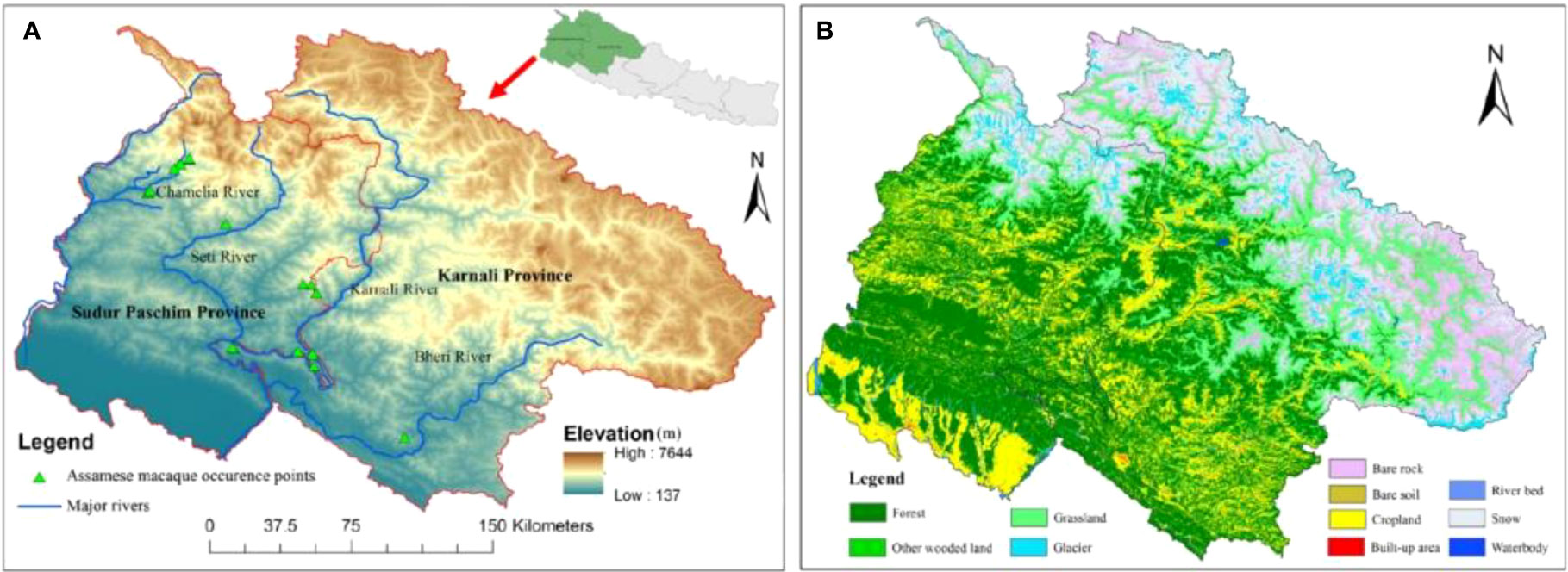
Figure 1 Map of Nepal showing the study areas in Karnali and Sudur Paschim provinces. (A) Map showing elevational range and Assamese macaque occurrence points; (B) Map showing the land use and land cover patterns of the study area.
2.2 Field surveys
Field surveys were conducted between December 2019 and December 2021 to identify existing groups of Assamese macaques and their composition. Surveys were done using existing foot trails along various segments of major river axis in the study area. The trails varied from an elevation of about 100 m asl to about 3,000 m asl. The basins of the Bheri River (Surkhet District), Karnali River (Dailekh, Surkhet and Achham districts), Seti River (Achham western, Doti and Bajhang), Chamelia River (Baitadi and Darchula districts) and Kailash Khola (Achham District) were surveyed.
The age and sex of the individuals were categorized into adults (male and female), sub-adult, juveniles and infants following Chalise (2003). Counting was repeated 3 to 4 times to minimize the bias in distinguishing age and sex of the group members. The geographic locations of the groups were noted by GPS (Garmin GPS MAP 4S). Beyond the major objective of the research, interviews of the local people also were conducted to help better understand the existing conservation threats to the species.
2.3 Environmental data for ecological niche modelling
A total 17 different occurrence coordinates of Assamese macaques from the far western Nepal were collected and used for the ecological niche modeling. Nineteen bioclimatic variables (Table 1) having spatial resolution of 30 arc second (~1 km2) were downloaded from the WorldClim database (https://www.worldclim.org). All bioclimatic variables were clipped to the boundary of Nepal using ArcGIS 10.5 and exported in ASCII format. Multicollinearity test among the 19 variables (Annex 1) was done using Pearson’s correlation test and only one variable was taken among two highly correlated variables with the threshold criteria of r ≤ |0.80|. Seven bioclimatic variables (Bio:1, 3, 7, 12, 14, 17, 18) were selected for the ecological niche modeling (ENM) after removing highly correlated variables.
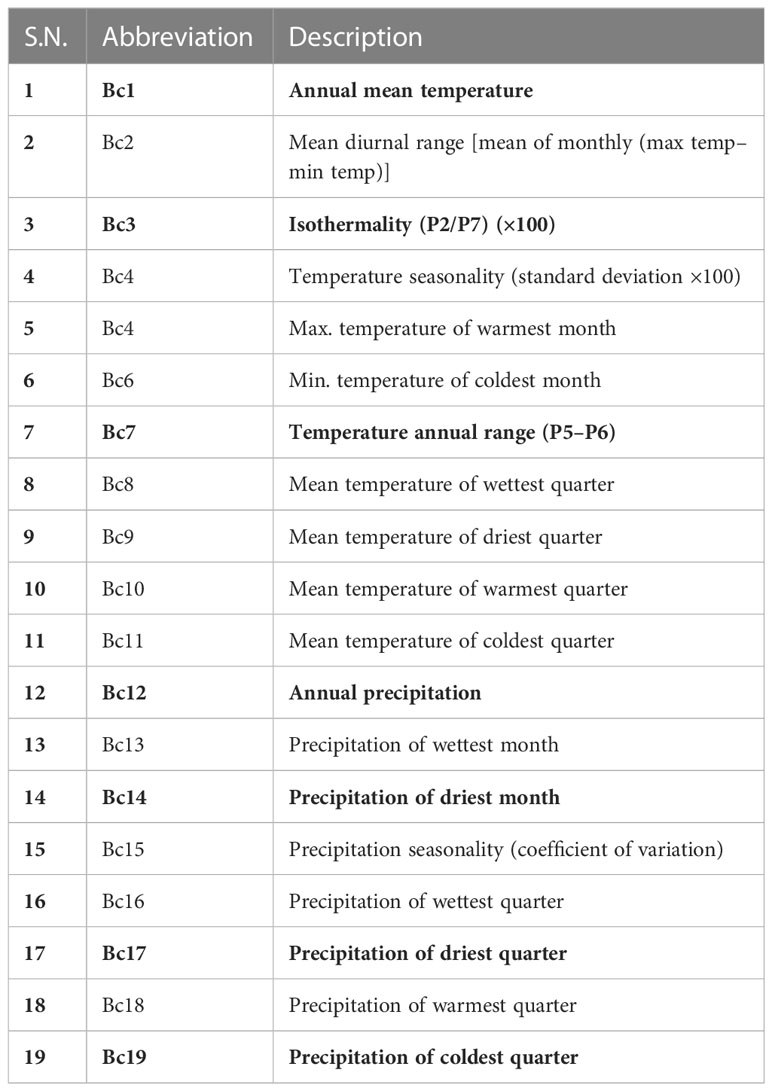
Table 1 List of 19 bioclimatic variables and their description (variables in the bold letters were used in the ENM).
2.4 Data analysis
2.4.1 Population parameters estimation
A group was defined following Hanya et al. (2003) and Plumptre and Cox (2006). The average group size, sex ratio (male: female), young to adult ratio, and infant ratio were calculated as follows:
2.4.2 Species distribution modeling in MaxEnt
Maximum entropy (MaxEnt) has been considered as one of the best tools to predict the potential distribution of species by ecological niche modeling (Phillips et al., 2006; Elith et al., 2011). It can use non-systematically collected occurrence records from a variety of sources (Elith et al., 2011). The current potential distribution of Assamese macaque was modelled using the MaxEnt v.3.4.1 (Phillips et al., 2006) applied with auto features. The presence data were divided into 75% random training dataset and 25% validation dataset. A total of 25 replication models based on cross-validation method were generated and the model accuracy was evaluated by area under the curve (AUC) of the receiving operating curve (ROC). AUC help in evaluating the success of the model with all possible thresholds. The robustness of the models was evaluated as if AUC ≥ 0.9 = very good, 0.9 > AUC ≥ 0.8 = good, and AUC< 0.8 = poor (Jiménez-Valverde, 2012). The Jacknife test was done to evaluate the contribution of environmental variables (Shcheglovitova & Anderson, 2013). The logistic output data were further categorized into four different groups such as<0.2 unsuitable, 0.21–0.4 moderately suitable, 0.41–0.60 suitable, and >0.6 highly suitable (Yang et al., 2013). By using the maximum training sensitivity and specificity cloglog (maxTSSClogLog = 0.33) in Arc GIS 10.5 and the number of pixels were counted in the attribute table of the reclassified map.
2.4.3 Projected distribution for the years 2050 and 2070
The climate-modelling community has developed four different greenhouse gas concentration trajectories referred to as Representative Concentration Pathways (RCPs): RCP2.6, RCP4.5, RCP6, and RCP8.5. Among the four, the most plausible RCPs are RCP 4.5 and RCP 6.0 (Pielke et al., 2022). Recent ‘stated policy’ scenarios of Working Group 1 of the Intergovernmental Panel on Climate Change (IPCC) AR6 and the International Energy Agency (IEA) are ‘approximately in line with the medium RCP4.5 and RCP6.0 (IPCC, 2013). Therefore, we selected RCP4.5 and RCP6.0 to project the predicted niche of the Assamese macaques for the years 2050 and 2070. In the RCP4.5 scenario, carbon dioxide emissions will peak in the middle of the century and then rapidly decline over the next 30 years. In the RCP6.0, emissions are expected to double by the year 2060 followed by a dramatic decrease. Future climate data of the MIROC5 (Model for Interdisciplinary Research On Climate) general circulation models (GCM) are considered to best capture the several observed features of future climate, particularly for the southern and eastern regions of Asia (Zahoor et al., 2021). Climatic data for 2050 and 2070 under RCP4.5 and RCP 6.0 of the MIROC5 GCM were downloaded from the WorldClim database (https://www.worldclim.org). The corresponding data of the selected seven variables used for predicted niche identification were retrieved for the years 2050 and 2070 and used in the MaxEnt for future projection of the niche.
2.4.4 Elevation-wise distribution of suitable habitats
The SRTM-DEM data of 10 m resolution for the study area were uploaded in the ArcMap 10.5 with the MaxEnt result for the calculation of the elevational distribution of the Assamese macaque. The output maps of the MaxEnt modeling were reclassified again into four different ranking: unsuitable, moderately suitable, suitable and highly suitable with values less than 0.20, 0.21–0.40, 0.41–0.60 and 0.61–1, respectively. By using the attribute table, the number of pixels for each category in the current and future (2050 and 2070) models were counted for both the RCPs (4.5 and 6.0).
3 Results
3.1 Population status and observed distribution
A total of 159 Assamese macaques belonging to 10 groups were observed across the study area in western Nepal. The group sizes ranged between 7–39 individuals with an average group size of 15.9 ± 9.7 individuals. The adult male to female sex ratio was 1:1.622 and infant to mother sex ratio was 0.56:1.
Eight groups (139 individuals) of Assamese macaques were recorded in Sudur Paschim Province and only two groups (20 individuals) were recorded east of the Karnali River in Karnali Province. Nine of the ten groups (145 individuals) were observed outside the protected area system of Nepal, except one group in the Api Nampa Conservation Area. The elevational range of the groups extended between 684m and 2,550m asl. On the basis of different elevation gradients, the maximum number of groups were recorded from 1,000m to 2,000m whereas the largest average group size (25.5) was observed at less than 1,000m elevation (Table 2).
3.2 The current potential distribution
The MaxEnt produced a robust model with the mean AUC 0.882 (SD=0.078) of 25 cross validation multiplication runs (Figure 2) suggesting the potential distribution of Assamese macaques fits well with observed distribution data. The Jackknife test revealed ‘Annual mean temperature’ (Bc01) had the highest contribution (31.9%) to the model followed by the ‘Precipitation of driest quarter’ (Bc17, 31.6%) and ‘Annual precipitation’ (Bc12, 16.6%) (Annex 2 & 3).
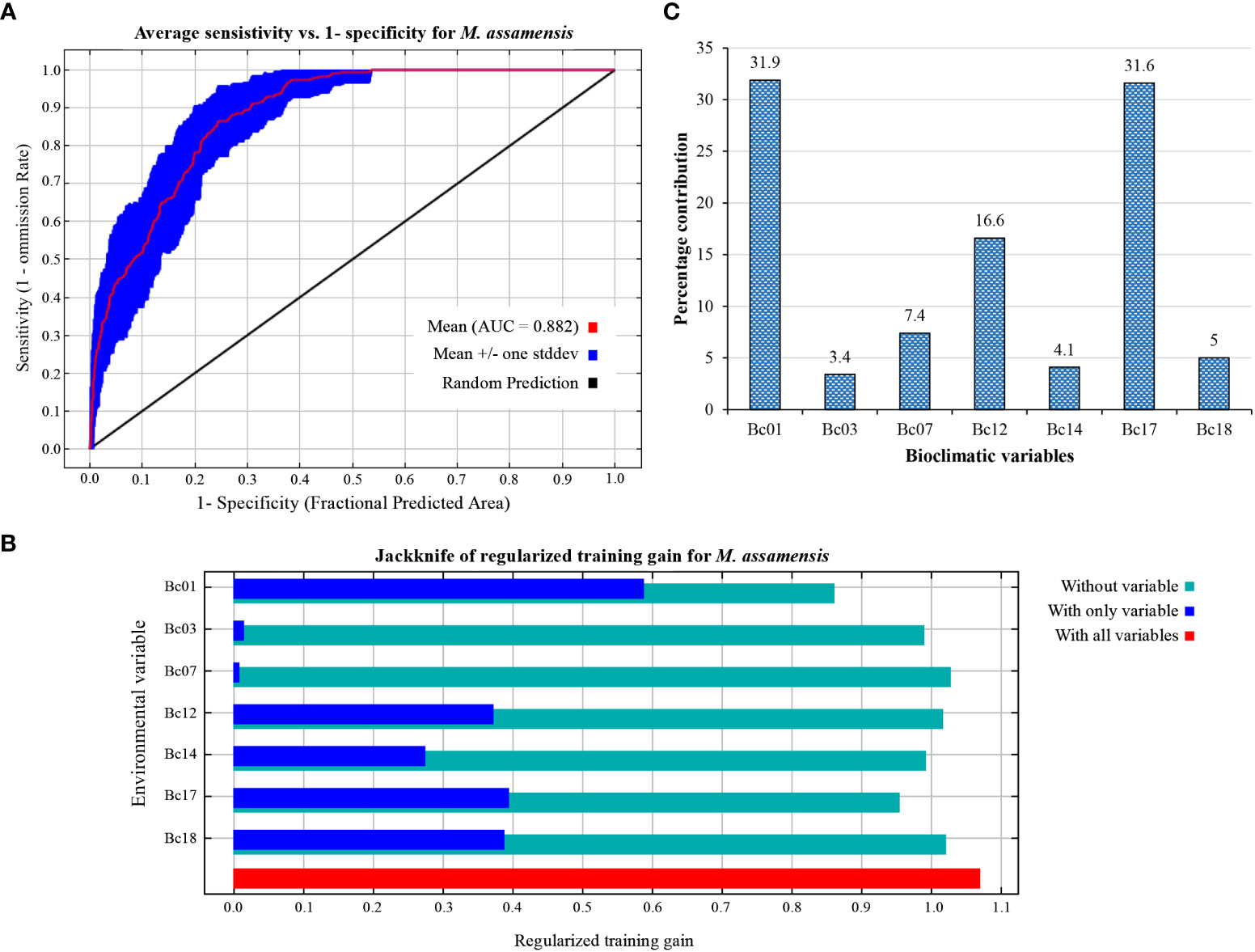
Figure 2 Model validation and contribution of different bioclimatic variations to the model. (A) Average area under curve (AUC) for 25 replicates of MaxEnt runs (red line is average value and blue bars represent ± 1 standard deviation; (B) Variable importance by Jackknife test for ENM of Assamese macaques (The blue, aqua and red bars represent the results with each variable, remaining all variables and all the variables, respectively); (C) Percentage contribution of bioclimatic variables to the model.
Out of the 67,813 km2 area of western Nepal, 37.03% (25,114 km2) of the area was considered suitable and 62.97% (42,699 km2) was unsuitable for Assamese macaques (Figure 3). Of the total suitable area, 16,697 km2 (24.63%) was moderately suitable, 7,024 km2 (10.35%) was suitable and 1,393 km2 (2.055%) was highly suitable. The current elevational range of suitable habitat was 140 m to 3,899 m asl. The majority of the suitable habitat ranged between 1,000 m and 2,000 m asl (Figure 4).
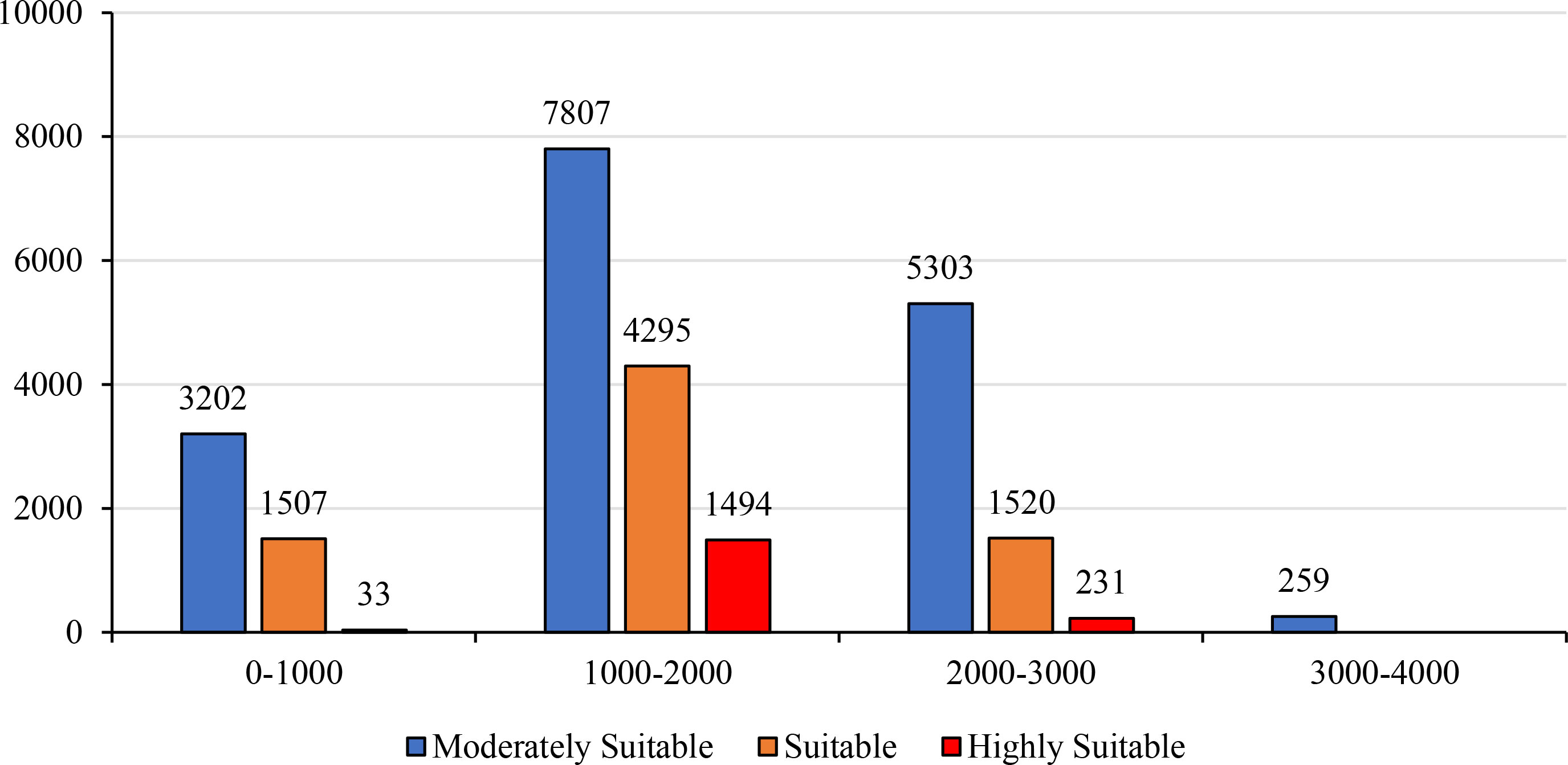
Figure 4 Current potential distribution areas for the westernmost subpopulation of Assamese macaques at different elevational range.
3.3 Future projected distribution under RCP4.5 and RCP6.0
Future projections of the current climatic niche of the Assamese macaques revealed a consistent decrease in the suitable habitats for 2050 ad 2070 in both greenhouse emission scenarios tested (Figure 5). At both RCPs, the suitable habitat will decrease compared to the present, but a relatively higher loss of habitat is predicted for lower elevations compared to that of the higher elevations.
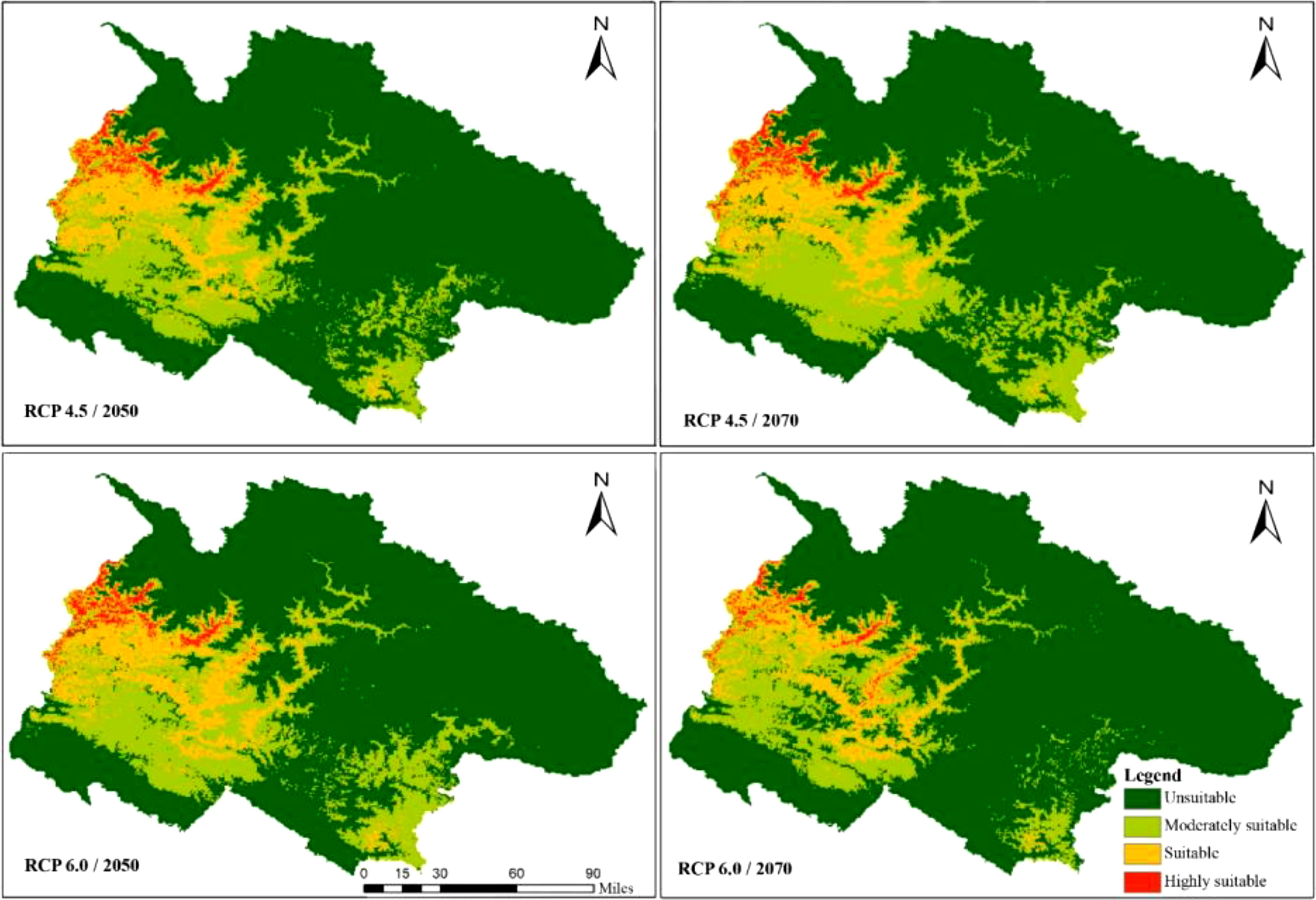
Figure 5 Future potential geographical distribution of Assamese macaques by 2050 and 2070 at greenhouse emission scenarios RCP4.5 and RCP6.0.
For the year 2050, at RCP4.5, the overall suitable area is predicted to decline from 37.03% to 28.34% (19,216 km2); and at RCP6.0, it declines to 27.35% (18,545 km2) (Table 3). The highest net decline was in the highly suitable habitat (32.6% decline at RCP4.5 and 52.83% decline at RCP6.0). For the year 2070, at RCP4.5, the overall suitable area decreases from current 37.03% of the total area to 28.78% (19,516 km2); and at RCP6.0, it decreases to 23.89% (16,201 km2) (Table 3). The projected model predicted for a net decline in 56.64% of the highly suitable habitats of the Assamese macaques by 2070 at RCP6.0.
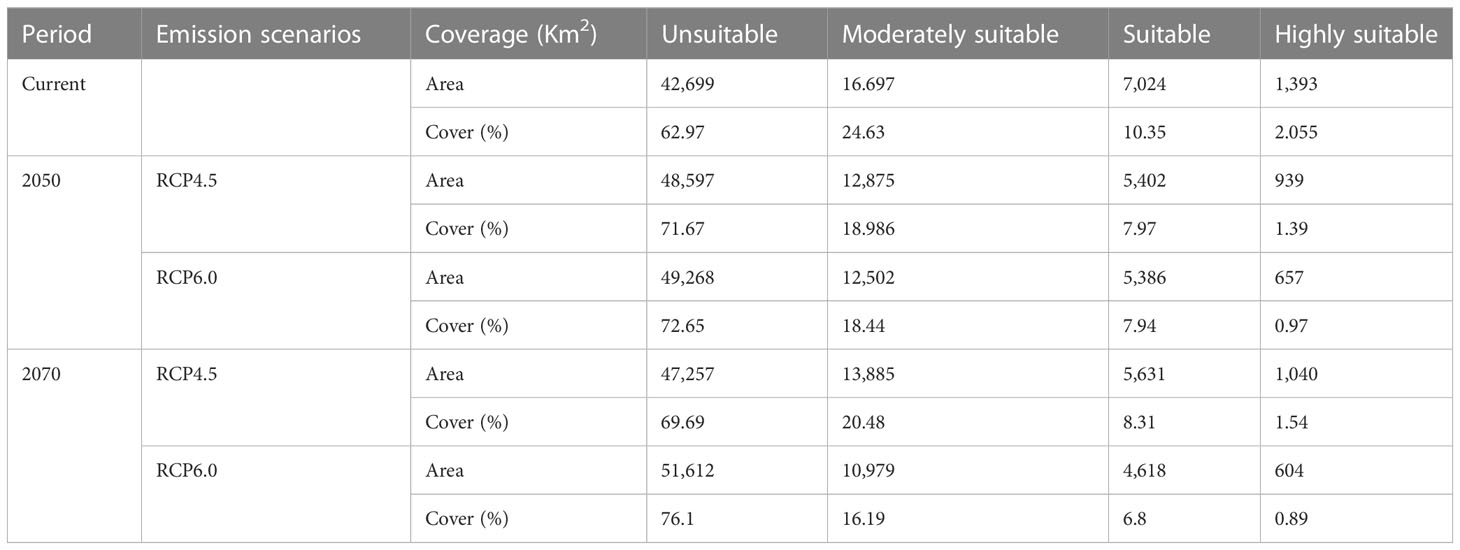
Table 3 Spatial analyses of the current and future potential geographical distribution in 2050 and 2070 of Assamese macaque.
The majority of the highly suitable habitat was at an elevation range between 1,000m to 2,000m asl. At RCP 6.0, almost 57% of the current highly suitable habitat (1,393 km2) would be lost by 2070 (604 km2) and will be shifted towards higher elevations. At both RCPs, the suitable habitat is decreased compared to the present, but a relatively higher loss of habitat is predicted for lower elevations compared to that of the higher elevations.
4 Discussion
4.1 Current population and distribution
This study recorded several new groups of the Assamese macaques in far-western Nepal that had not been previously reported in the scientific literature. Earlier studies considered the Kaligandaki River, in the central Nepal, as the westernmost distribution limit of the global population of the Assamese macaque species (Groves, 2001; Wada, 2005; Boonratana et al., 2020). This current study extends our earlier work (Khanal et al., 2019) by documenting seven additional groups distributed beyond our previous reports. The average group size of the Assamese macaque in far-western Nepal (15.5) is much lower than the previous reported national averages: 21.55 (Chalise, 2013), 19.29 (Khanal et al., 2019), and 23.6 (in Langtang National Park, central Nepal (Regmi & Kandel, 2008)). We acknowledge that the current survey data on the population of Assamese macaques in western Nepal does not represent a thorough systematic population survey but provides useful information for subsequent studies. The elevational distribution of Assamese macaques in western Nepal appears different from those of the eastern Nepal. The lowest recorded elevation of the species in eastern Nepal is 130 m asl (Khanal et al., 2018) whereas it was found to be above 684 m asl in the western Nepal. Western Nepal lies at a relatively higher latitude and also receives less precipitation from the South-Asian summer monsoon during the rainy season (Shrestha et al., 2000; Kansakar et al., 2004).
Majority of the Assamese macaque groups in far-western Nepal are found outside the protected area system, whereas about half of the overall national population of the species is estimated to live within protected areas (Khanal et al., 2019). Among the ten groups recorded in this study, nine were observed from the riverine broad-leaved forest represented by tree species such as Adina cordifolia, Bombax ceiba, Ficus racemosa, Mallotus philippensis, Schima wallichi, Syzygium cumini, Toona ciliate, etc. and associated climber plants. The groups were recorded close to the water resources such as rivers, rivulets or streams. These results were consistent with those reported for the species in eastern and central Nepal (Chalise, 2013; Khanal et al., 2019), Bhutan (Kawamoto et al., 2006; Choudhury, 2008) and north-eastern India (Choudhury, 2018).
The habitat suitability modeling obtained an average AUC value of 0.87 suggesting a good level of accuracy and the current occurrence of the Assamese macaques falls within the predicted areas. The model revealed potential distribution areas of the Assamese macaques in the mid-hills of Achham, Doti, Baitadi, and Darchula districts. It also showed that most of the suitable areas for the species lie in temperate and sub-tropical mid-hill broad leaf forests. Assamese macaques prefer mid-hill areas with broad leaf forests around river basins within the elevation range between 140m to 2,650m (Chalise, 2003; Chalise et al., 2013; Khanal et al., 2019). The predicted elevational range for the species in western Nepal is much higher (140 m to 3,899 m asl) than that of the eastern Nepal (85 m to 2,987 m asl) (Khanal et al., 2019). Annual mean temperature was the major bioclimatic variable defining the niche of Assamese macaques. Similar results were reported for the Himalayan musk deer (Lamsal et al., 2018). Besides average annual temperature, precipitation related indices such as ‘Precipitation of driest quarter’ (Bc17, 31.6%) and ‘Annual precipitation (Bc12, 16.6%) also contributed in the predicted ecological niche of Assamese macaques in the far-western Nepal. As alluded to earlier, Western Nepal is much drier than eastern Nepal as the former receives less precipitation from the south Asian summer monsoon than the former.
4.2 Impact of climate change on distribution
The most prominent consequence of climate change on the Himalayan fauna is the loss of habitat. Our results suggest that Assamese macaques could lose 35.5% of their current suitable habitat (25,114 km2) by 2070 at RCP6.0 (16,201 km2). Such a loss of habitat would impact the already threatened and sporadically distributed (Khanal et al., 2019) small subpopulation of the Assamese macaques in Far-western Nepal. Many mammals, including herbivores and their predators, of the Himalayan regions are predicted to lose their current suitable habitats under climate change. For example, snow leopards (Panthera uncia) and blue sheep (Pseudois nayaur) (Aryal et al., 2016), Himalayan musk deer (Moschus chrysogaster) (Lamsal et al., 2018), bats (Thapa et al., 2021), etc. in the Nepal Himalaya are predicted to lose a significant proportion of their current habitat in the future.
Besides the loss of suitable habitat, another important ecological consequence of the climate change is range shift of the flora and fauna as they seek refuge for the global warming. For example, is has been predicted that Himalayan langurs (Semnopithecus schistaceus) will shift their distribution range along both longitude and latitude to find refuge from climate change in areas that are not presently protected forests (Bagaria et al., 2020). Similarly, Zahoor et al. (2021) predicted an elevational range shift of the Asiatic black bear (Ursus thibetanus) towards the higher Himalaya and speculated about additional ecological consequences such as increased human-bear conflict and bear mortality.
4.3 Conservation implications
The westernmost population of the Assamese macaque in far-western Nepal is small in size, sporadically distributed in fragmented forests, and not well studied. The groups in this region have remained relatively unknown until just recently with the majority living outside of the protected area system. In many locations around Nepal, including the far-western region, human-macaque conflict is high (Koirala et al., 2021). Subsistence farmers lose a substantial amount of crops due to crop raiding by the macaques. Conversely, the macaques suffer injuries and even loss of life due to a multitudes of mitigation measures employed by the local people (Joshi et al., 2020), including retaliatory killing in extreme cases.
In Nepal, as in many Asian countries, macaques are considered as a pest species and many local governments have employed measures to control them by chasing, capturing, sterilization, translocation, and even culling. We observed that a large proportion of the local people in far-western Nepal are not able to distinguish the Assamese macaque from the main nuisance species, the rhesus macaque. The people also are unaware of the protected status of the Assamese macaque per the Nepal’s national law. Therefore, despite the official government mandated protection via the National Parks and Wildlife Protection Act 1973 of Nepal, Assamese macaques continue to be targeted by local people and are often injured or even killed.
The population of Assamese macaques from the far-western Nepal has received little attention by the national and international scientific communities and management authorities due a lack of study and remoteness of the area. Our current study discovered previously unreported groups of the macaques with all but one group living outside of protected areas. The ecological niche modeling revealed their current potential distribution areas and the projection for a shift in the suitable habitat towards higher elevation. This projected range shift, together with the expected increase in human-macaque conflict will further complicate the already compounding management issues faced by the government. To help prepare for the expected climate-related changes, a more proactive approach is needed. Given that the mid-hills region of far-western Nepal lacks a continuous protected area network (Lamsal et al., 2018), we believe it would be prudent that the Assamese macaque population in far-western Nepal be given a high conservation priority (along with the awareness campaigns to help minimize the human-macaque conflict), and the establishment of new protected areas and management strategies.
5 Conclusion
This study assessed the population status and distribution of the Assamese macaques in western Nepal and identified their current climatic niche by habitat suitability modelling. The majority of the population in this far western region currently reside outside the protected area network of the country. About one-third of the area of western Nepal has been found to be suitable for the species. However, the species is predicted to lose a substantial portion of its suitable habitat in the future due to the ongoing climate change. The present study provides important baseline information needed to help formulate and implement the conservation strategies for the Assamese macaques and help mitigate the impending effects of climate change.
Data availability statement
The raw data supporting the conclusions of this article will be made available by the authors, without undue reservation.
Ethics statement
Ethical approval was not required for the study involving animals in accordance with the local legislation and institutional requirements because no animals were handled. Required permission was obtained from government authorities.
Author contributions
LK conceived the idea and designed the study. LK, LU, NP, DC, and MK collected the data. LK, LU and NP performed data analysis and wrote the manuscript. MKC and RCK revised the manuscript. All authors contributed to the article and approved the submitted version.
Funding
This work was supported in part by a Rufford Small Grant (Grant No. 29201-2) of the Rufford Foundation, UK. RCK’s effort was supported in part by the National Institutes of Health (NIH) Office of Research Infrastructure Programs (ORIP) under award number P51OD010425 to the Washington National Primate Research Center, USA.
Acknowledgments
We thank the Department of National Parks, and Department of Forest and Soil Conservation, Government of Nepal for permission to conduct the study. We are thankful to the local people for their support during the study.
Conflict of interest
The authors declare that the research was conducted in the absence of any commercial or financial relationships that could be construed as a potential conflict of interest.
Publisher’s note
All claims expressed in this article are solely those of the authors and do not necessarily represent those of their affiliated organizations, or those of the publisher, the editors and the reviewers. Any product that may be evaluated in this article, or claim that may be made by its manufacturer, is not guaranteed or endorsed by the publisher.
References
Adhikari K. P., Khanal L., Chalise M. K. (2018). Status and effects of food provisoning on ecology of Assamese monkey (Macaca assamensis) in Ramdi area of Palpa, Nepal. J. Institute Sci. Technol. 22, 183–190. doi: 10.3126/jist.v22i2.19611
Aryal A., Shrestha U. B., Ji W., Ale S. B., Shrestha S., Ingty T., et al. (2016). Predicting the distributions of predator (snow leopard) and prey (blue sheep) under climate change in the Himalaya. Ecol. Evol. 6, 4065–4075. doi: 10.1002/ece3.2196
Asahi K. (2010). Equilibrium-line altitudes of the present and Last Glacial Maximum in the eastern Nepal Himalayas and their implications for SW monsoon climate. Quaternary Int. 212, 26–34. doi: 10.1016/j.quaint.2008.08.004
Bagaria P., Sharma L. K., Joshi B. D., Kumar H., Mukherjee T., Thakur M., et al. (2020). West to east shift in range predicted for Himalayan Langur in climate change scenario. Global Ecol. Conserv. 22, e00926. doi: 10.1016/j.gecco.2020.e00926
Bhattacharyya S., Mungi N. A., Kawamichi T., Rawat G. S., Adhikari B. S., Wilkening J. L. (2019). Insights from present distribution of an alpine mammal Royle’s pika (Ochotona roylei) to predict future climate change impacts in the Himalaya. Regional Environ. Change 19, 2423–2435. doi: 10.1007/s10113-019-01556-x
Boonratana R., Chalise M. K., Das J., Htun S., Timmins R. J. (2020). Macaca assamensis. In: The IUCN red list of threatened species 2020: e.T12549A17950189 (Accessed 05 February 2023).
Chalise M. K. (2005). Characteristics of the Assamese monkey (Macaca assamensis) of Nepal. Am. J. Primatol. 66, 195.
Chalise M. K. (2013). Fragmented primate population of Nepal. Primates in fragments: Complexity and resilience. Eds. Marsh L. K., Chapman C. A. (New York: Springer Science+Business Media), 329–356. doi: 10.1007/978-1-4614-8839-2_22
Chalise M. K., Karki J. B., Ghimire M. K. (2005). “Status in Nepal: non-human primates,” in Special issue on the occasion of 10th Wildlife Week (Kathmandu, Nepal: 2062 Department of National Parks & Wildlife Conservation), 19–26.
Chalise M. K., Ogawa H., Pandey B. (2013). Assamese monkeys in Nagarjun forest of Shivapuri Nagarjun National Park. Tribhuvan Univ. J. 28, 181–189. doi: 10.3126/tuj.v28i1-2.26240
Choudhury A. (2008). Primates of Bhutan and observations of hybrid langurs. Primate Conserv. 23, 65–73. doi: 10.1896/052.023.0107
Choudhury A. (2018). Photographic record of the Assamese macaque Macaca assamensis in Tripura, Northeastern India. Asian Primates J. 7, 2–5.
Choudhury A. (2022). A review of the Assamese macaque macaca assamensis complex and its geographical variation. Primate Conserv. 36, 203–231.
DNPWC (2023). Khaptad National Park (Government of Nepal. Kathmandu: Department of National Parks and Wildlife Conservation). Available at: https://dnpwc.gov.np/en/conservation-area-detail/77/.
Elith J., Phillips S. J., Hastie T., Dudík M., Chee Y. E., Yates C. J. (2011). A statistical explanation of MaxEnt for ecologists. Diversity Distributions 17, 43–57. doi: 10.1111/j.1472-4642.2010.00725.x
Hanya G., Yoshihiro S., Zamma K., Kubo R., Takahata Y. (2003). New method to census primate groups: Estimating group density of Japanese macaques by point census. Am. J. Primatol. 60, 43–56. doi: 10.1002/ajp.10079
IPCC (2013). “Summary for policymakers,” in Climate change 2013: the physical science basis. Contribution of working group I to the fifth assessment report of the intergovernmental panel on climate change. Eds. Stocker T. F., Qin D., Plattner G. K., et al (Cambridge, United Kingdom and New York, NY, USA: Cambridge University Press).
Jiménez-Valverde A. (2012). Insights into the area under the receiver operating characteristic curve (AUC) as a discrimination measure in species distribution modelling. Global Ecol. Biogeogr. 21, 498–507. doi: 10.1111/j.1466-8238.2011.00683.x
Joshi G., Neupane B., Dahal D., Shrestha S., Dhakal P., Jandug C. M. B., et al. (2020). Assessment of human-wildlife conflict in Kailali district of Nepal. J. Anim. Diversity 2, 24–36. doi: 10.29252/jad.2020.2.3.5
Kansakar S. R., Hannah D. M., Gerrard J., Rees G. (2004). Spatial pattern in the precipitation regime of Nepal. Int. J. Climatology: A J. R. Meteorological Soc. 24, 1645–1659. doi: 10.1002/joc.1098
Kawamoto Y., Aimi M., Wangchuk T. (2006). Distribution of Assamese macaques (Macaca assamensis) in the inner Himalayan region of Bhutan and their mtDNA diversity. Primates 47, 388–392. doi: 10.1007/s10329-006-0192-x
Khanal L., Chalise M. K., Fan P. F., Kyes R. C., Jiang X. L. (2021). Multilocus phylogeny suggests a distinct species status for the Nepal population of Assam macaques (Macaca assamensis): implications for evolution and conservation. Zoological Res. 42, 3–13. doi: 10.24272/j.issn.2095-8137.2020.279
Khanal L., Chalise M. K., He K., Acharya B. K., Kawamoto Y., Jiang X. L. (2018). Mitochondrial DNA analyses and ecological niche modeling reveal post-LGM expansion of the Assam macaque (Macaca assamensis) in the foothills of Nepal Himalaya. Am. J. Primatol. 80, e22748. doi: 10.1002/ajp.22748
Khanal L., Chalise M. K., Jiang X. L. (2019). Distribution of the threatened Assamese macaque Macaca assamensis (MamMalia: Primates: Cercopithecidae) population in Nepal. J. Threatened Taxa 11, 13047–13057. doi: 10.11609/jott.4623.11.1.13047-13057
Khatri K., Jha B. R., Gurung S., Khadka U. R. (2020). Freshwater fish diversity and its conservation status in different water bodies of Nepal. Nepal J. Environ. Sci. 8, 39–52. doi: 10.3126/njes.v8i1.34442
Koirala S., Garber P. A., Somasundaram D., Katuwal H. B., Ren B., Huang C., et al. (2021). Factors affecting the crop raiding behavior of wild rhesus macaques in Nepal: Implications for wildlife management. J. Environ. Manage. 297, 113331. doi: 10.1016/j.jenvman.2021.113331
Lamsal P., Kumar L., Aryal A., Atreya K. (2018). Future climate and habitat distribution of Himalayan Musk Deer (Moschus chrysogaster). Ecol. Inf. 44, 101–108. doi: 10.1016/j.ecoinf.2018.02.004
Molur S., Brandon-Jones D., Dittus W., Eudey A., Kumar A., Singh M., et al. (2003). Status of south asian primates : conservation assessment and management plan (C.A.M.P.) workshop report 2003 (Coimbatore, India: Zoo Outreach Organisation/CBSG-South Asia).
Paudel J., Khanal L., Pandey N., Upadhyaya L. P., Sunar C. B., Thapa B., et al. (2023). Determinants of herpetofaunal diversity in a threatened wetland ecosystem: A case study of the ramaroshan wetland complex, western Nepal. Animals 13, 135. doi: 10.3390/ani13010135
Phillips S. J., Anderson R. P., Schapire R. E. (2006). Maximum entropy modeling of species geographic distributions. Ecol. Model. 190, 231–259. doi: 10.1016/j.ecolmodel.2005.03.026
Pielke R. Jr., Burgess M. G., Ritchie J. (2022). Plausible 2005–2050 emissions scenarios project between 2°C and 3°C of warming by 2100. Environ. Res. Lett. 17, 024027. doi: 10.1088/1748-9326/ac4ebf
Plumptre A. J., Cox D. (2006). Counting primates for conservation: primate surveys in Uganda. Primates 47, 65–73. doi: 10.1007/s10329-005-0146-8
Regmi G. R., Kandel K. (2008). Population status, threats and conservation measures of Assamese macaque (Macaca assamensis) in Langtang National Park (Nepal. UK: Primate Society of Great Britain).
Roos C., Boonratana R., Supriatna J., Fellowes J. R., Groves C., Nash S. D., et al. (2014). An upadated taxonomy and conservation status review of Asian primates. Asian Primates J. 4, 2–20.
Shcheglovitova M., Anderson R. P. (2013). Estimating optimal complexity for ecological niche models: A jackknife approach for species with small sample sizes. Ecol. Model. 269, 9–17. doi: 10.1016/j.ecolmodel.2013.08.011
Shrestha U. B., Gautam S., Bawa K. S. (2012). Widespread climate change in the Himalayas and associated changes in local ecosystems. PloS One 7, e36741. doi: 10.1371/journal.pone.0036741
Shrestha A. B., Wake C. P., Dibb J. E., Mayewski P. A. (2000). Precipitation fluctuations in the Nepal Himalaya and its vicinity and relationship with some large scale climatological parameters. Int. J. Climatology: A J. R. Meteorological Soc. 20, 317–327. doi: 10.1002/(SICI)1097-0088(20000315)20:3<317::AID-JOC476>3.0.CO;2-G
Thapa S., Baral S., Hu Y., Huang Z., Yue Y., Dhakal M., et al. (2021). Will climate change impact distribution of bats in Nepal Himalayas? A case study of five species. Global Ecol. Conserv. 26, e01483. doi: 10.1016/j.gecco.2021.e01483
Wada K. (2005). The distribution pattern of rhesus and Assamese monkeys in Nepal. Primates 46, 115–119. doi: 10.1007/s10329-004-0112-x
Yang X.-Q., Kushwaha S. P. S., Saran S., Xu J., Roy P. S. (2013). Maxent modeling for predicting the potential distribution of medicinal plant, Justicia adhatoda L. @ in Lesser Himalayan foothills. Ecol. Eng. 51, 83–87. doi: 10.1016/j.ecoleng.2012.12.004
Keywords: global warming, habitat loss, Nepal Himalaya, niche modeling, range shift
Citation: Khanal L, Upadhyaya LP, Pandey N, Chand DB, Karki M, Chalise MK and Kyes RC (2023) Projected distribution of the westernmost subpopulation of Assamese macaques (Macaca assamensis pelops) under climate change: conservation implications of a threatened population. Front. Conserv. Sci. 4:1235595. doi: 10.3389/fcosc.2023.1235595
Received: 06 June 2023; Accepted: 02 August 2023;
Published: 18 August 2023.
Edited by:
William J. McShea, Smithsonian Conservation Biology Institute (SI), United StatesReviewed by:
Gopala Àreendran, World Wide Fund for Nature, IndiaMewa Singh, University of Mysore, India
Copyright © 2023 Khanal, Upadhyaya, Pandey, Chand, Karki, Chalise and Kyes. This is an open-access article distributed under the terms of the Creative Commons Attribution License (CC BY). The use, distribution or reproduction in other forums is permitted, provided the original author(s) and the copyright owner(s) are credited and that the original publication in this journal is cited, in accordance with accepted academic practice. No use, distribution or reproduction is permitted which does not comply with these terms.
*Correspondence: Laxman Khanal, bGtoYW5hbEBjZHp0dS5lZHUubnA=
†These authors have contributed equally to this work
 Laxman Khanal
Laxman Khanal Laxmi Prasad Upadhyaya
Laxmi Prasad Upadhyaya Naresh Pandey
Naresh Pandey Dhirendra Bahadur Chand
Dhirendra Bahadur Chand Melina Karki
Melina Karki Mukesh Kumar Chalise
Mukesh Kumar Chalise Randall C. Kyes
Randall C. Kyes